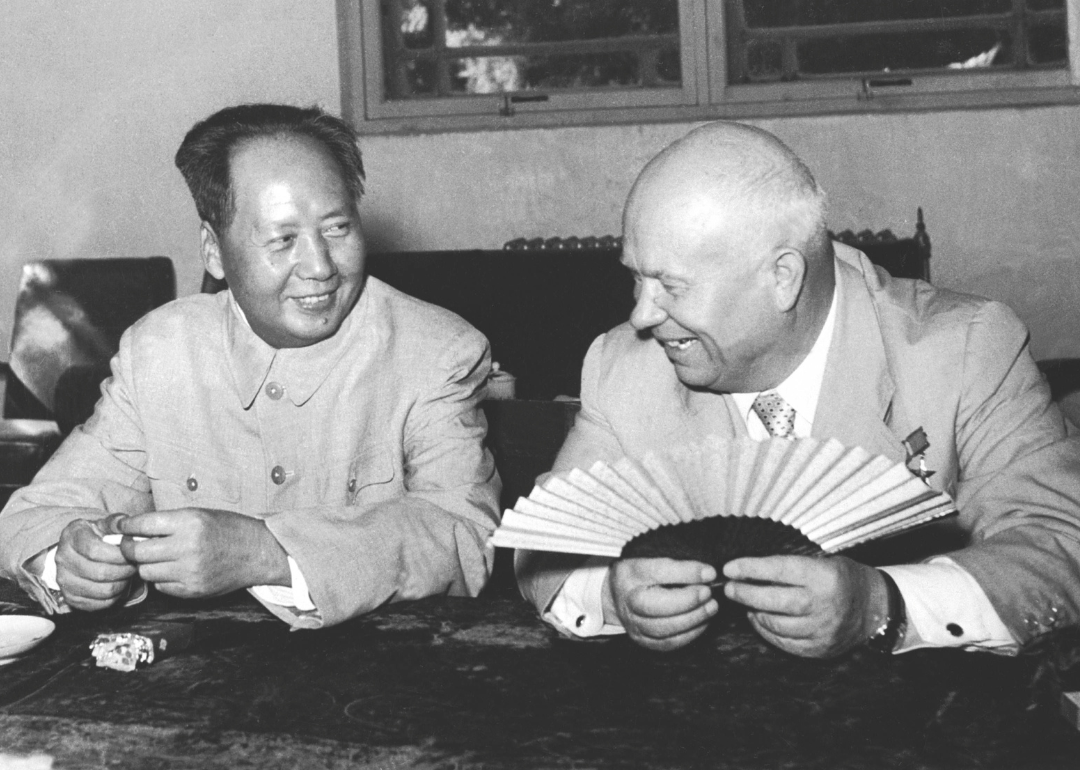
Russia and China in the last 100 years: The love-hate relationship between the world's largest communist powers
Russia and China in the last 100 years: The love-hate relationship between the world's largest communist powers
The relationship between Russia and China is a decadeslong story of push and pull between the world's largest Communist superpowers. It started as a younger brother-elder brother relationship, with China looking to Russia for guidance and support in the mid-20th century as the Chinese Communist Party took hold and began mapping out its rise. This relationship began to shift in balance following the dissolution of the Soviet bloc and has continued to vacillate in either country's favor ever since.
Ideological differences, notably regarding interactions with Western countries and other key pillars of communism, left both countries in cold contact for several stretches of time. Border disputes have led to violence. Ultimately, collaboration on gas and oil trade and the development of the Belt and Road Initiative—a widespread and complex infrastructure initiative aimed at connecting East Asia with Europe—have kept the two countries in a public-facing partnership.
Several recent events, however, have left the future of Sino-Russian relations in question.
On the one hand, the two nations renewed the Sino-Russian Treaty of Friendship in June 2021, and even more recently issued a joint statement on strengthening international relations, following Russian President Vladimir Putin's visit to China in February 2022.
On the other hand, China has been reluctant to publicly support Russia's invasion of Ukraine. Short of formally denouncing the unprovoked invasion, China has seemingly made clear that its silence on the matter is contingent on there being no nuclear escalation; the country has also refused to recognize the recent annexation of four Ukrainian territories by Russia.
Understanding the evolution of these two nations' relationship is a key factor in examining both the impact of communism on the world stage and the U.S. and other allied nations' position regarding the ongoing war in Ukraine. Stacker investigated the relationship between Russia and China during the last century, using a variety of historical, news, and other sources. By looking back at the ebb and flow of Sino-Russian relations, it may be possible to understand better where both nations are headed in the coming years.
You may also like: Nobel Prize history from the year you were born
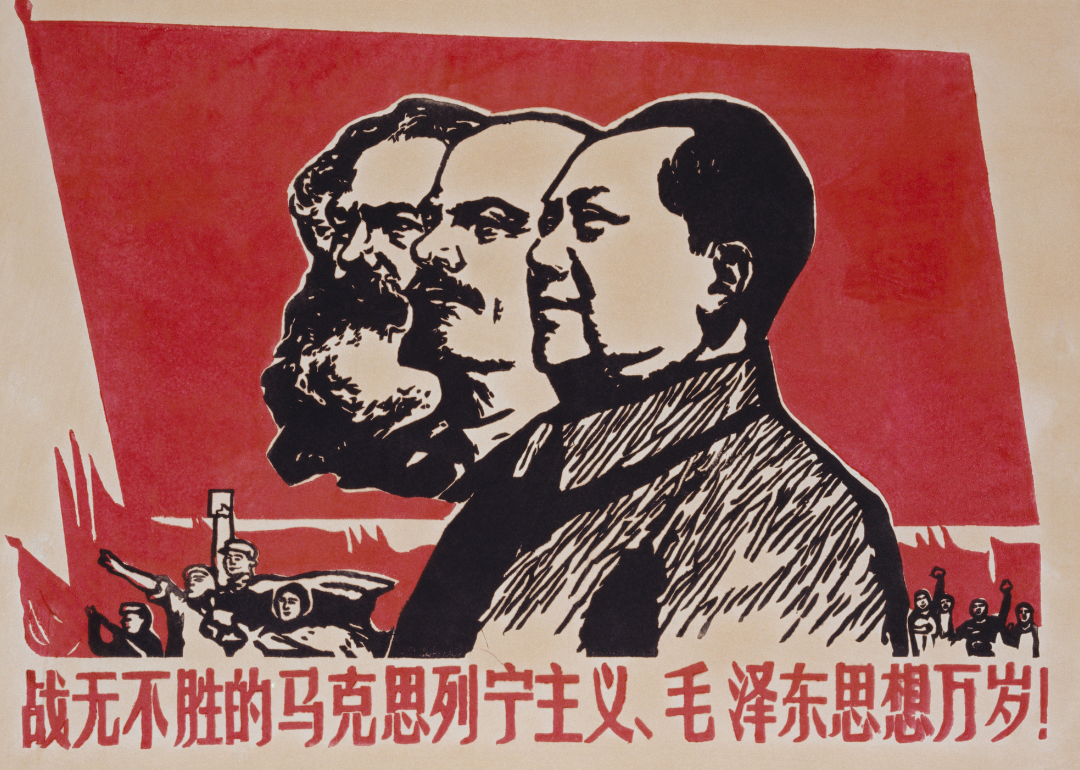
Oct. 2, 1949: Soviet Union recognizes the People's Republic of China, one day after its proclamation in Beijing
The Chinese Communist Party formally established the People's Republic of China on Oct. 1, 1949, following a long-running civil war between the CCP and the ruling Nationalist Party establishment. The next day, Russia's Deputy Foreign Minister Andrei Gromyko gave a speech over public radio recognizing the legitimacy of the new republic "with the proposal to establish diplomatic relations between the People's Republic of China and the Soviet Union." The Soviet Union had already begun to position itself to gain economic and diplomatic advantages from the triumph of the CCP by aiding the party in its fight for power.
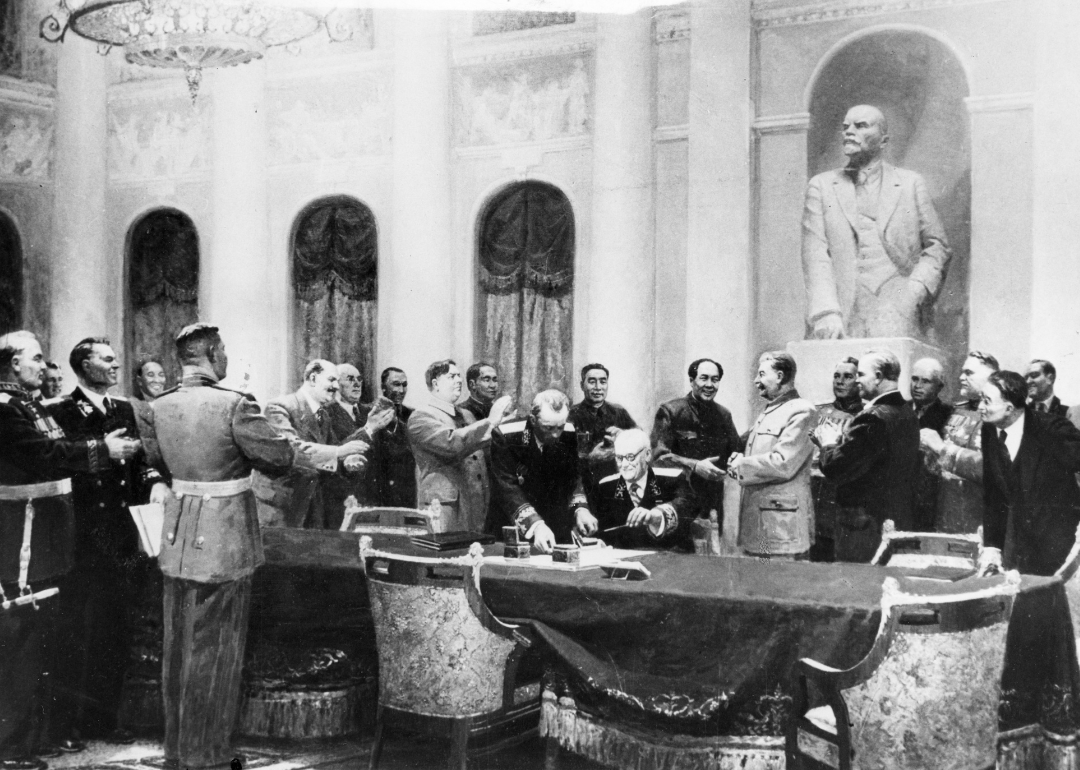
Feb. 15, 1950: China and the Soviet Union sign Treaty on Friendship, Union, and Mutual Assistance
The Soviet Union quickly made good on its intentions to solidify a relationship with the People's Republic of China, signing the Treaty on Friendship, Union, and Mutual Assistance within the first five months of the Republic's establishment. The treaty established a relationship in which China was the "younger brother" to Russia's "elder brother," a distinction buoyed by China's new position on the national stage. Through the agreement, the Soviet Union provided significant economic, military, and technological aid to the burgeoning Republic, ultimately playing a central role in shaping China's new economy and infrastructure.
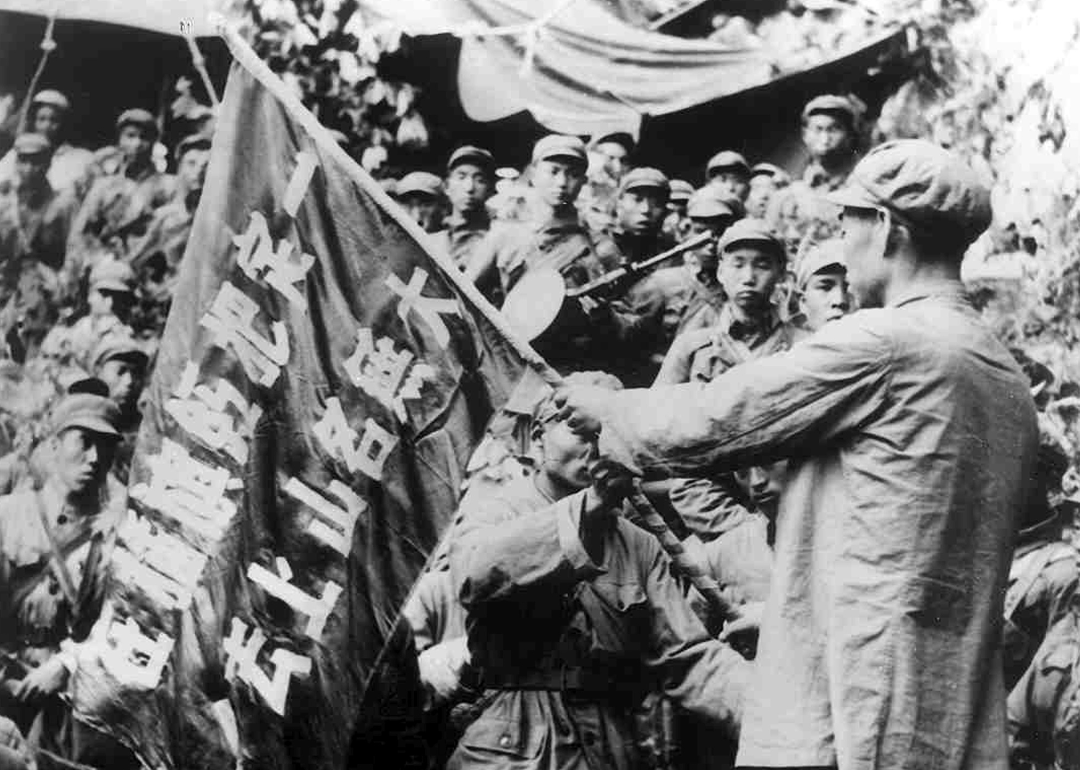
1950-1953: China and the Soviet Union collaborate to help communist North Korea in its war with South Korea and the West
The still-young People's Republic of China had limited abilities to aid North Korea on the ground during what was largely a war between the Communist East and Democratic West. Consequently, China depended on funds, equipment, military knowledge, and personnel from Russia to assist their neighbor. When the Korean War ended with an armistice in 1953, China was in debt to the Soviet Union to the tune of 3 billion yuan (the current equivalent of more than $400 million).
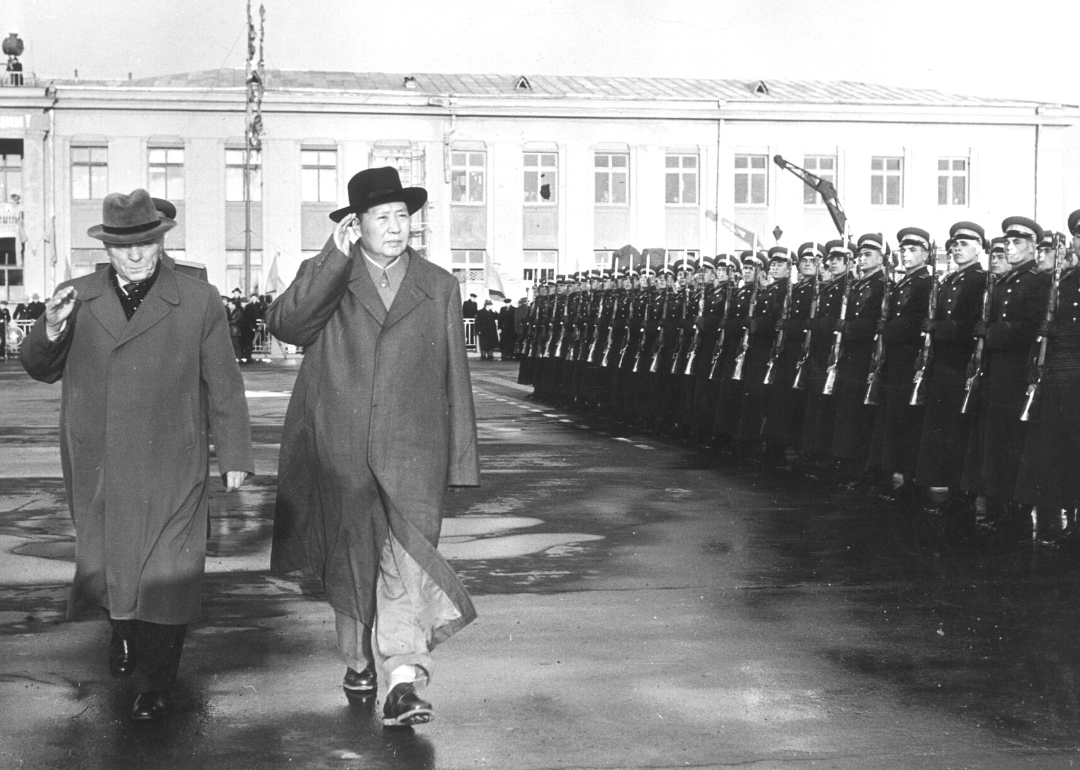
1953-1957: China implements first Five-Year Plan with aid from the Soviet Union, including funding 156 major industrial projects in China
China implemented its first Five-Year Plan with the financial help and ideological guidance of the Soviet Union, which had been using the structure of five-year plans to grow for several decades. The inaugural plan focused on economic growth through two key pillars: developing the mining, iron, and steel manufacturing industries, and leaning less on agriculture. In doing so, China mimicked Russia's emphasis on industrial development but found that its much larger population and technological developments were poorly suited to that roadmap. The People's Republic of China again found itself in debt to the Soviet Union following a series of loans to help get public industries off the ground.
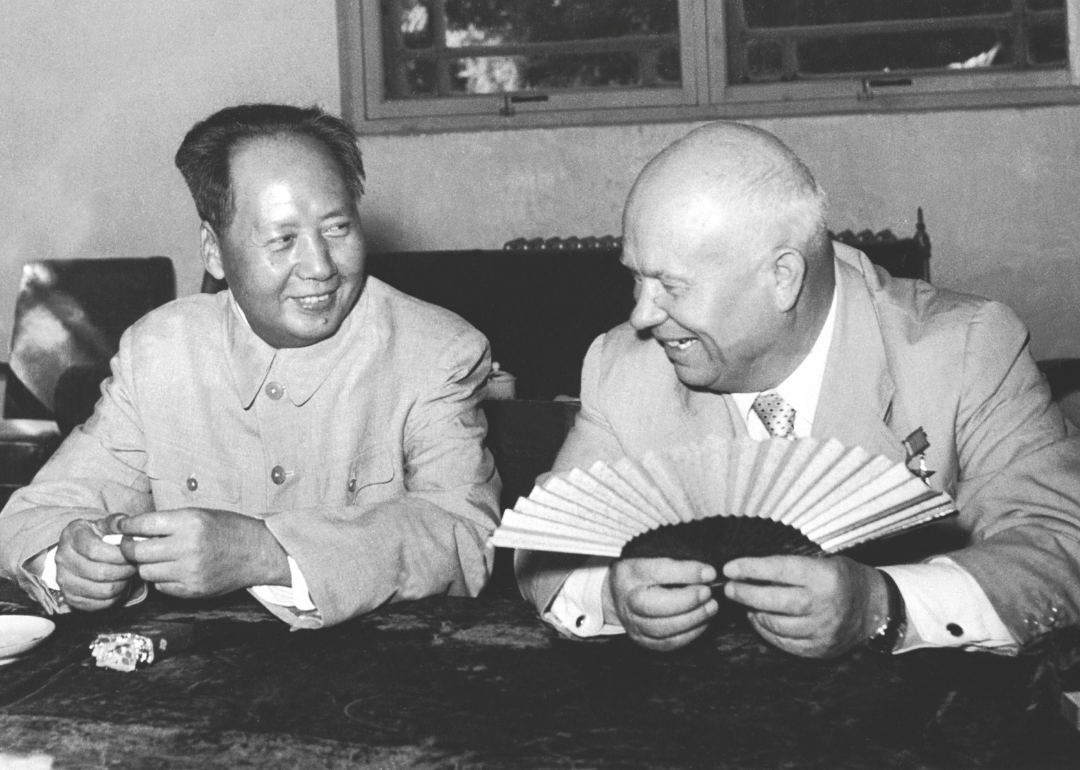
1960-1989: A Sino-Soviet split forms as Chinese leader Mao Zedong and Soviet leader Nikita Khrushchev distance themselves ideologically
The Soviet Union and People's Republic of China found that they were less aligned in character than originally thought following disagreements over core Communist ideology and how to interact with the West—China preferred an aggressive offense, while Russia believed in "peaceful coexistence." These tensions came to a head in 1969, when the Chinese military opened fire on Russian troops guarding the contested island of Zhenbao/Damanski on the Sino-Soviet border. By the onset of the 1980s, the Treaty on Friendship expired, and the two nations began a period of no contact.
You may also like: History of flight from the year you were born
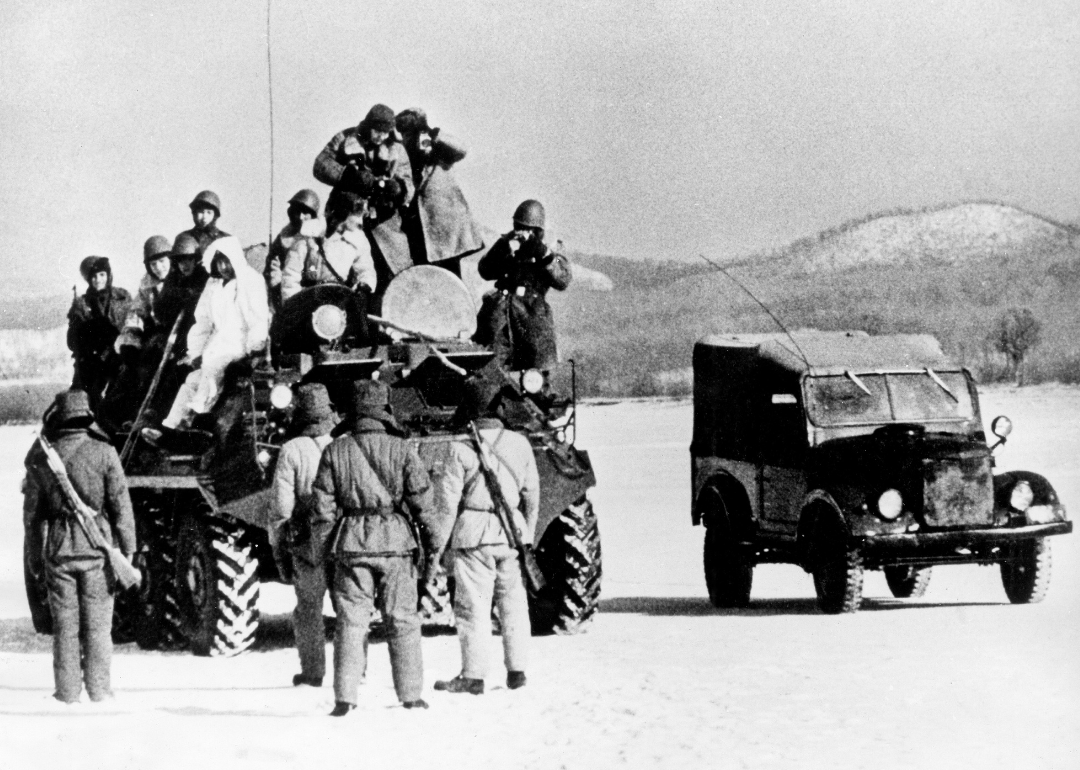
Spring-Summer 1969: Soviet and Chinese troops engage in clashes along the border of the two countries
Differences went from diplomatic to violent in March 1969, when Chinese forces killed 50 Soviet Union soldiers during a boundary dispute along the Ussuri River. In the wake of the conflict, the possibility of Russia using nuclear weapons against China was high. Another violent fight broke out in August 1969, when the People's Republic of China attempted to cross into and occupy Soviet territory at Zhalanashkol Lake in the Kazakh Socialist Soviet Republic. By September, representatives from both nations were able to engage in conversation and end the border dispute without further armed conflict.
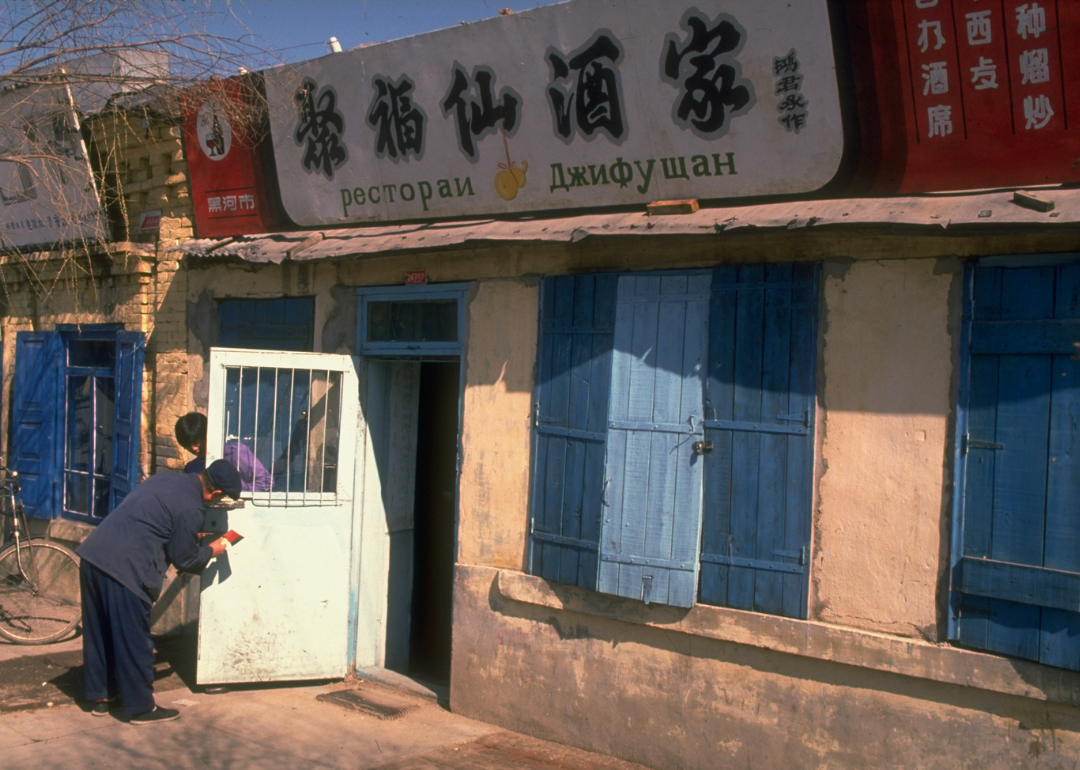
Late 1982: China and the Soviet Union restart dialogue to normalize ties
After more than a decade of mutual separation following the conflicts of the late 1960s, China and Russia began tentatively communicating again, due, in large part, to China's opening up to the West, which allowed the nation to be less dependent on the Soviet Union and shift more toward a global diplomatic balance. Consequently, Russia and China began to seek normalization with each other, divorced from the ideological constraints that underlay much of their previous conflict.
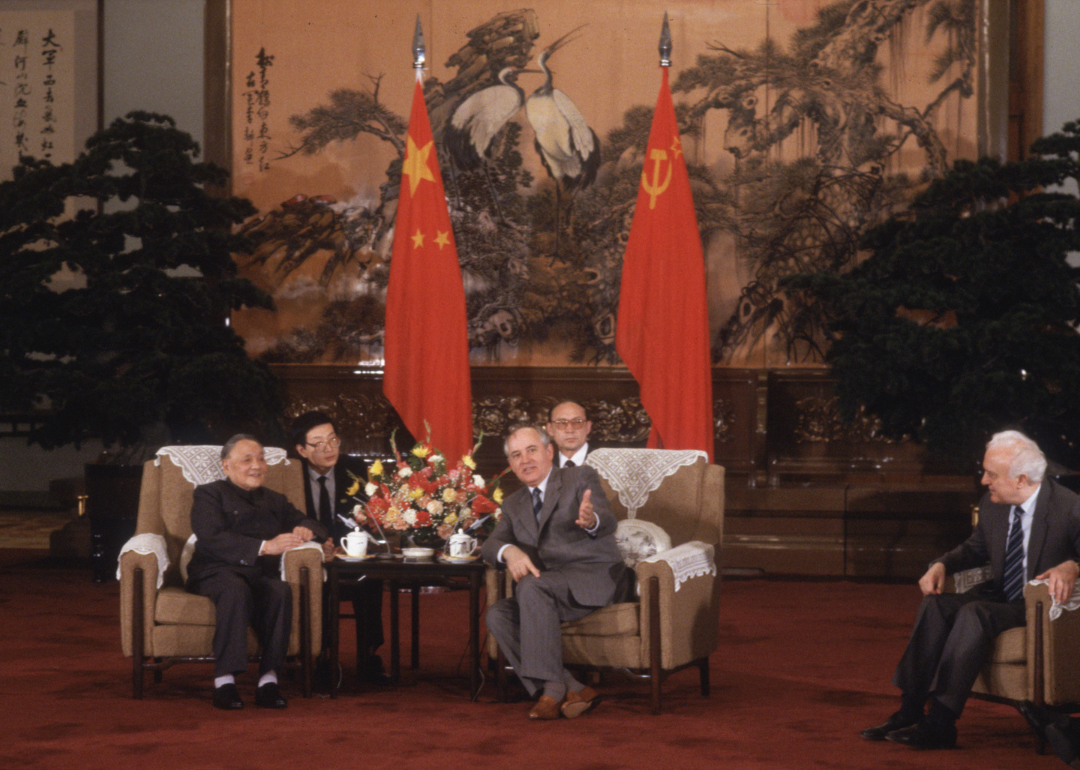
May 1989: During a visit to China, Soviet President Mikhail Gorbachev agrees to full normalization of relations with leader Deng Xiaoping
Mikhail Gorbachev's visit to Beijing marked the first visit from a Soviet ruler to China in three decades, the last being Nikita Khrushchev's visit in September 1959. The ensuing Sino-Soviet Summit saw talks between Gorbachev, Deng Xiaoping, Chinese President Yang Shangkun, General Secretary of the CCP Zhao Ziyang, and People's Republic of China Premier Li Peng that resulted in official normalization between the two nations, with agreements to collaborate on economic development and diffusing military tension along shared borders through open communication channels.
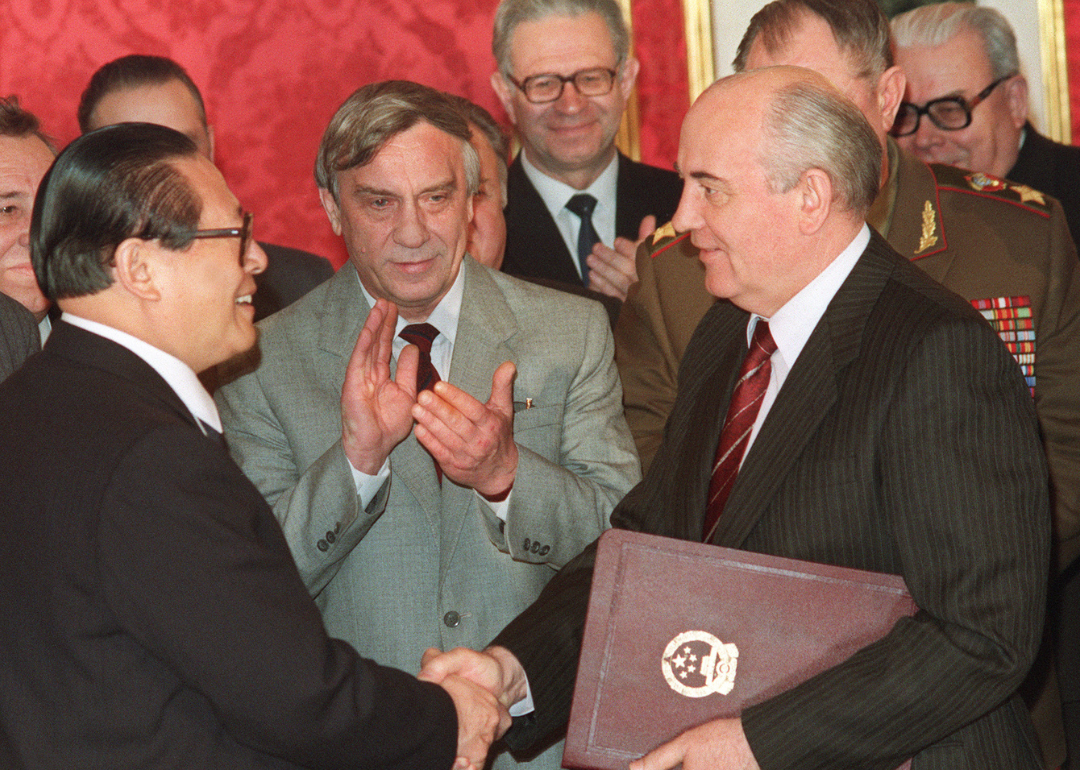
May 1991: Jiang Zemin, head of the Chinese Communist Party, visits Moscow; a pact marking the eastern sector of the two countries' borders follows
President Jiang Zemin's visit to Moscow was the first from a Chinese leader to the Kremlin in 34 years. After Jiang confirmed the border conflicts between the two countries were settled, Mikhail Gorbachev announced publicly that "there is every ground to state that a new Chinese-Soviet relationship, due to joint efforts, has successfully stood the test and already yields tangible fruit." On May 16, the two leaders signed a pact divvying up agreed sections of the Sino-Soviet border, though some portions of the 4,600-mile border remained unresolved.
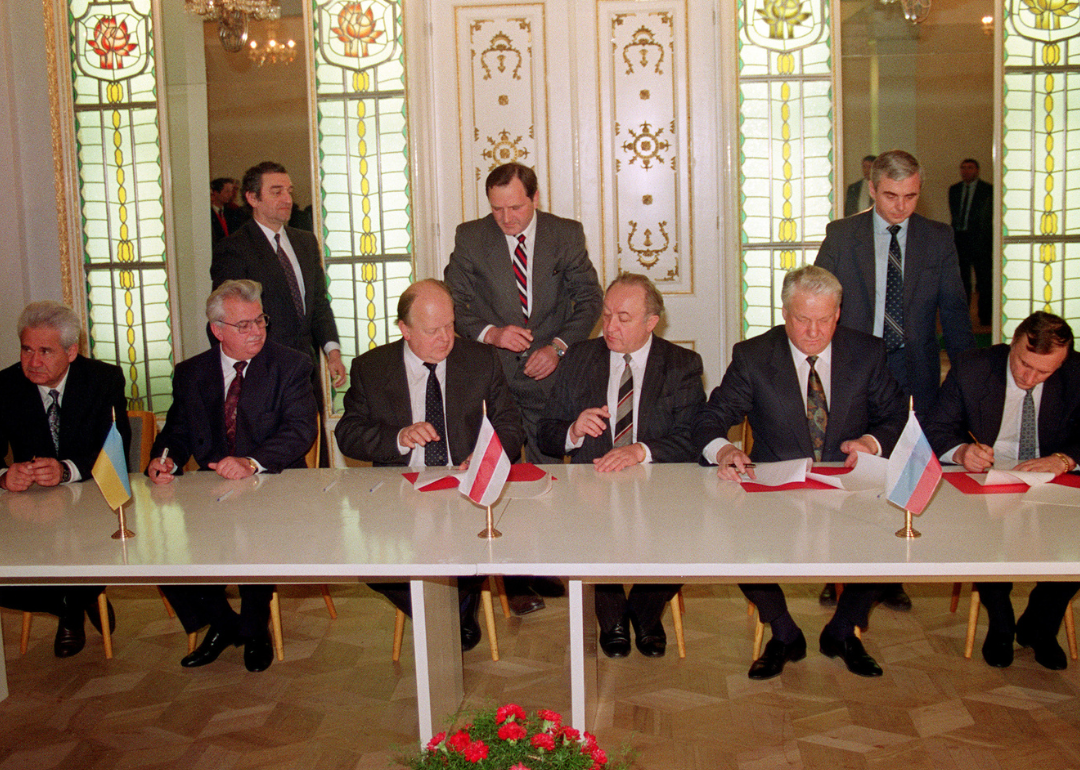
Dec. 8, 1991: Russia, Ukraine, and Belarus break up the Soviet Union and form the Commonwealth of Independent States
Russia joined forces with Ukraine and Belarus to form the Commonwealth of Independent States in a direct effort to replace the crumbling USSR. The three nations were soon joined by Kazakhstan, Kyrgyzstan, Tajikistan, Turkmenistan, Uzbekistan, Armenia, Azerbaijan, Georgia, and Moldova, to collaborate on jointly developing their economic and defense strategies, immigration and international diplomacy, and many other governmental establishments. Although member nations attempted to share command of their militaries and nuclear weapons, this proved difficult to achieve.
You may also like: How the world changed during Queen Elizabeth's reign
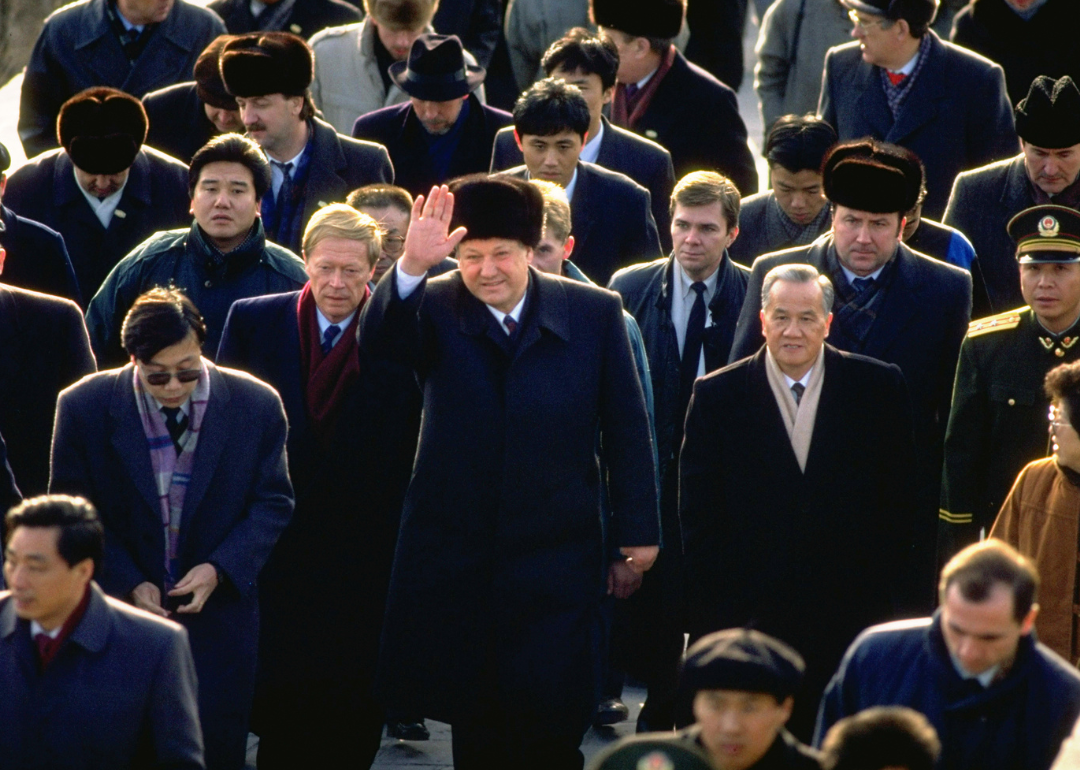
Dec. 18, 1992: Russian President Boris Yeltsin officially visits China for the first time, though the visit is cut short
Within two days of arriving in Beijing, Boris Yeltsin signed 24 agreements with the Chinese government, including planning for collaboration on technology and scientific developments, the construction of a nuclear power plant, and minimizing armed forces along the countries' shared border. Russia and China signed a new declaration of friendship, notably promising never to conduct a first nuclear offense against the other. This marked what Yeltsin declared a "new stage" of friendship and mutual cooperation between the two nations.
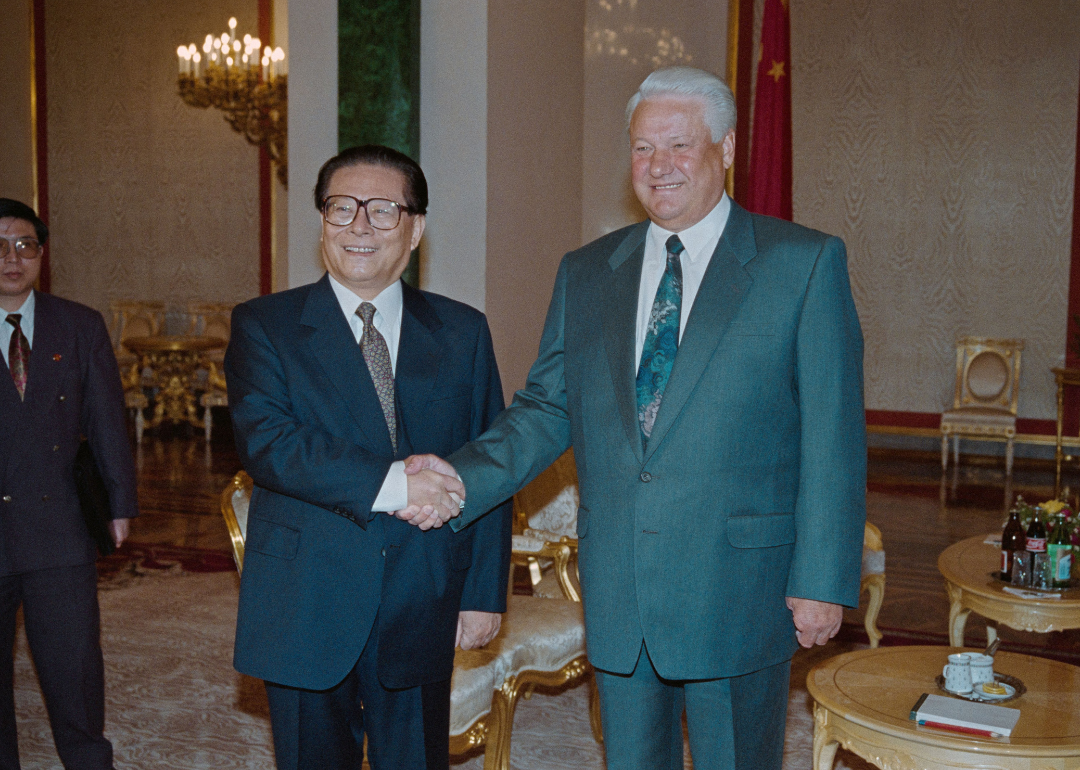
Sept. 3, 1994: Russia and China sign an agreement on the placement of the western sector of their border and agree not to target each other with nuclear weapons
The Treaty of the Western Section of the Sino-Russia Border was signed during People's Republic of China President Jiang Zemin's visit to Russia. It was ratified fully by both countries by July 1995. Under the agreement, 34 miles of the western border portion was demarcated; this process was completed by 1998.
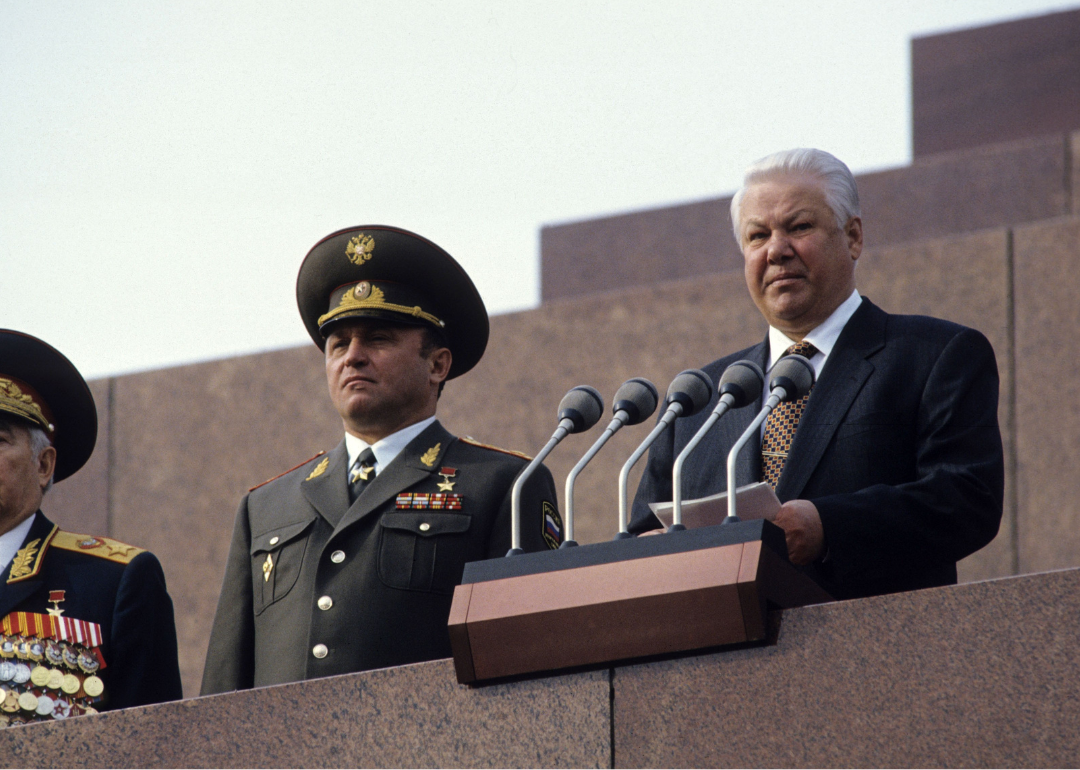
May 1995: Chinese President Jiang Zemin visits Moscow to participate in celebrations of the 50th anniversary of the Allied victory in WWII
Jiang Zemin, along with U.S. President Bill Clinton, was invited by Russian President Boris Yeltsin to commemorate the anniversary of the end of World War II, a conflict in which the two nations together suffered the greatest number of casualties. While in Moscow, the two leaders met to formally reconfirm their intention to continue to pursue peaceful relations and to respect the 1994 treaty to maintain peace along the Sino-Soviet border.
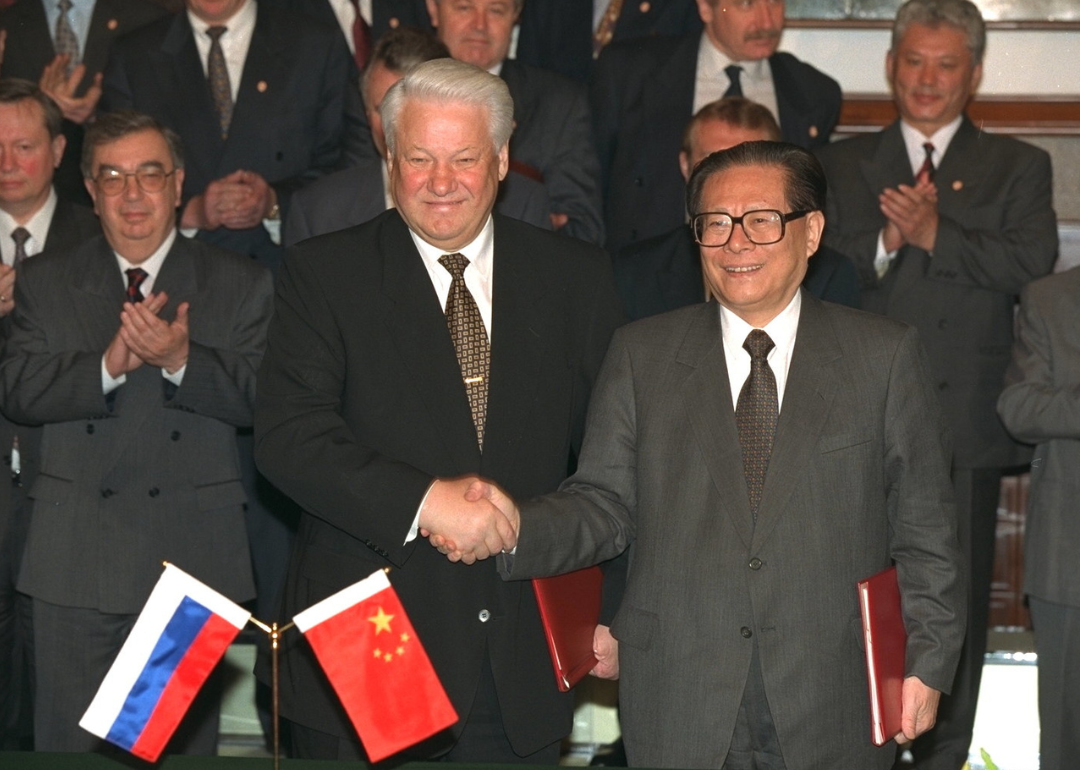
April 25, 1996: Russian President Boris Yeltsin visits China to discuss 'strategic partnership'
Presidents Boris Yeltsin and Jiang Zemin participated in a bilateral summit in Beijing, during which the term "strategic partnership" was used for the first time to describe the relationship between Russia and China. Fourteen agreements were signed during the summit, all aimed toward cementing an "equal, trusting partnership aimed at strategic cooperation in the twenty-first century." Immediately following their meeting, both leaders signed a shared border agreement with Kyrgyzstan, Tajikistan, and Kazakhstan, resulting in the Shanghai-5 (consisting of China, Kazakhstan, Kyrgyzstan, Russia, and Tajikistan), which has since developed into the Shanghai Cooperation Organization.
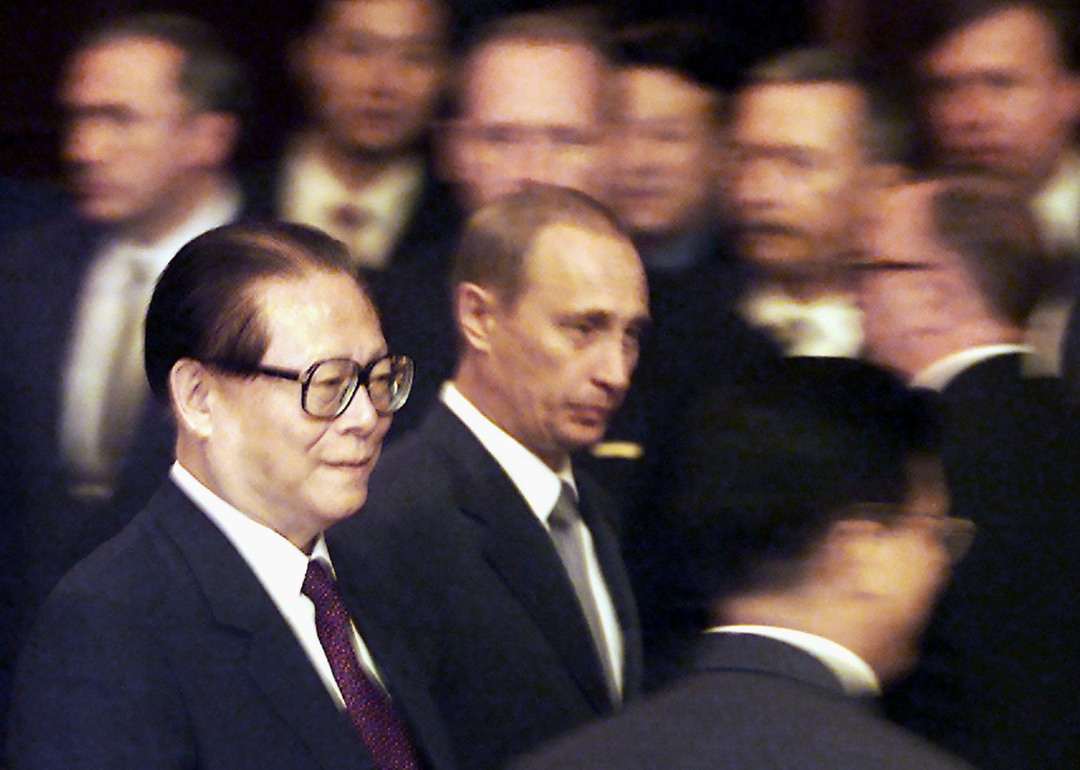
July 18, 2000: Russian President Vladimir Putin and Chinese President Jiang Zemin hold a summit in Beijing, finishing with a joint statement saying missile shields for the US and Asia threaten a new arms race
President Vladimir Putin visited China with the goal to "develop our relations by coordinating efforts on the world stage to tackle security, economic, and regional cooperation problems." During his time in Beijing, Putin and Jiang Zemin signed the Beijing Declaration, which laid plans for collaboration toward economic and technological development, as well as intentions to combat ethnic separatism and religious extremism. The leaders also decried the United States' Anti-Ballistic Missile Defense, devised to deflect incoming international missile attacks.
You may also like: Countries spending the most on their militaries
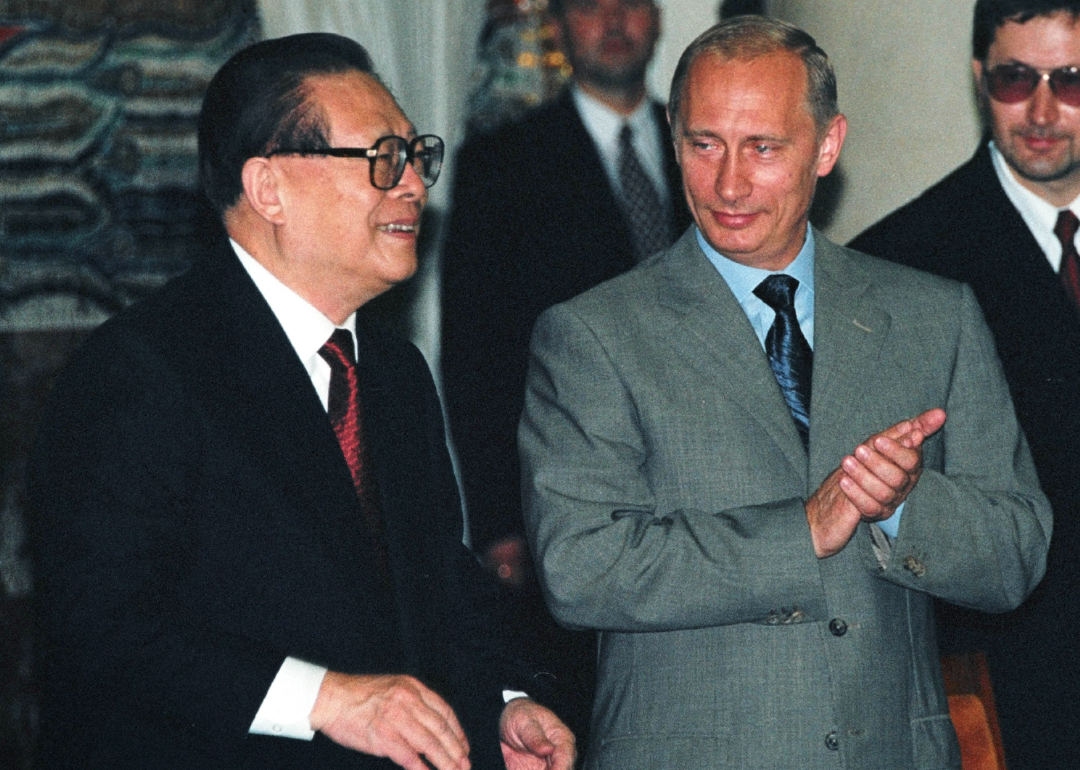
July 16, 2001: Vladimir Putin and Jiang Zemin sign the Treaty of Good Neighborliness and Friendly Cooperation, intended to protect mutual interests and stimulate trade
One year after declaring intentions to strengthen ties, Russia and China signed a Treaty of Good Neighborliness and Friendly Cooperation. In it, they agreed on "promoting and establishing a just and fair new world order based on universally recognized principles and norms of international laws" and to "endeavor to enhance relations between the two countries to a completely new level." It is thought that China's motivations in signing the treaty lay in its need for increased military capacity and a stable petroleum supply, while Russia was seeking markets for both of those sectors.
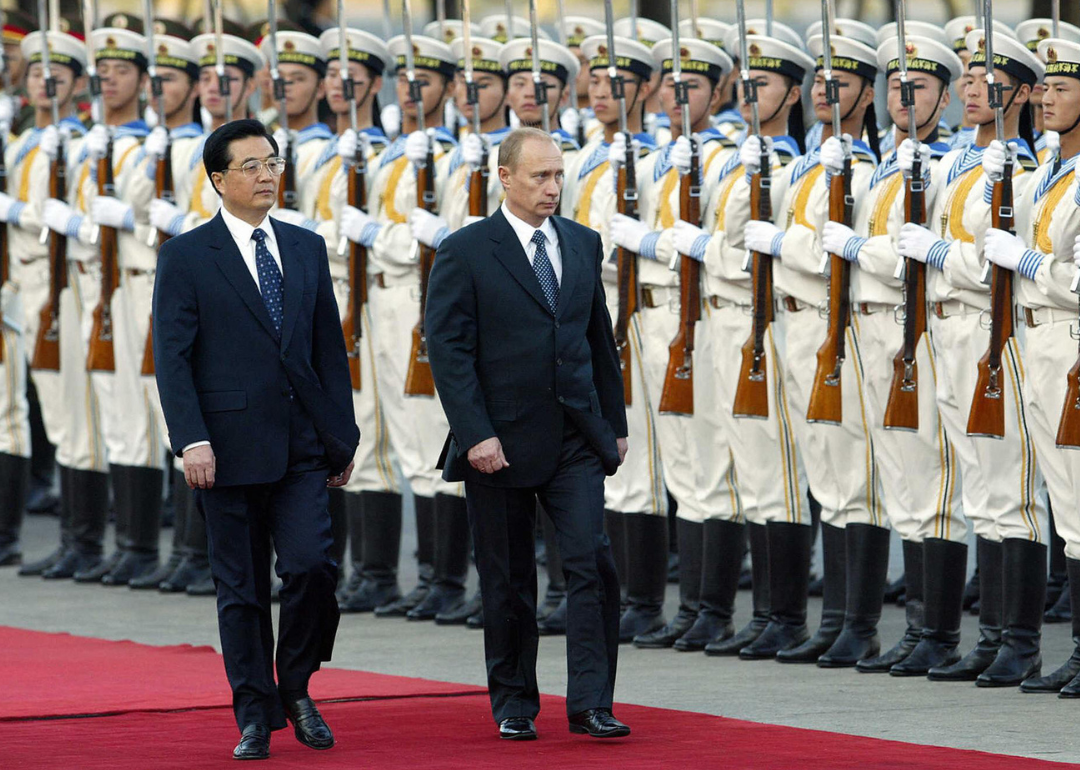
Oct. 15, 2004: Russia and China finalize their border demarcation; Russian gas company Gazprom and China oil company CNPC sign partnership deal within the month
The straggling portions of the Sino-Russian border that had remained unresolved after the 1991 pact were finally settled after a series of negotiations between Vladimir Putin and Chinese President Hu Jintao. The resulting agreement granted one formerly contested island to each country. At the same time, China National Petroleum Corporation, the largest state-owned petroleum company in China, signed an Agreement of Strategic Cooperation with Russian-owned gas company Gazprom, arranging joint exportation and gas processing.
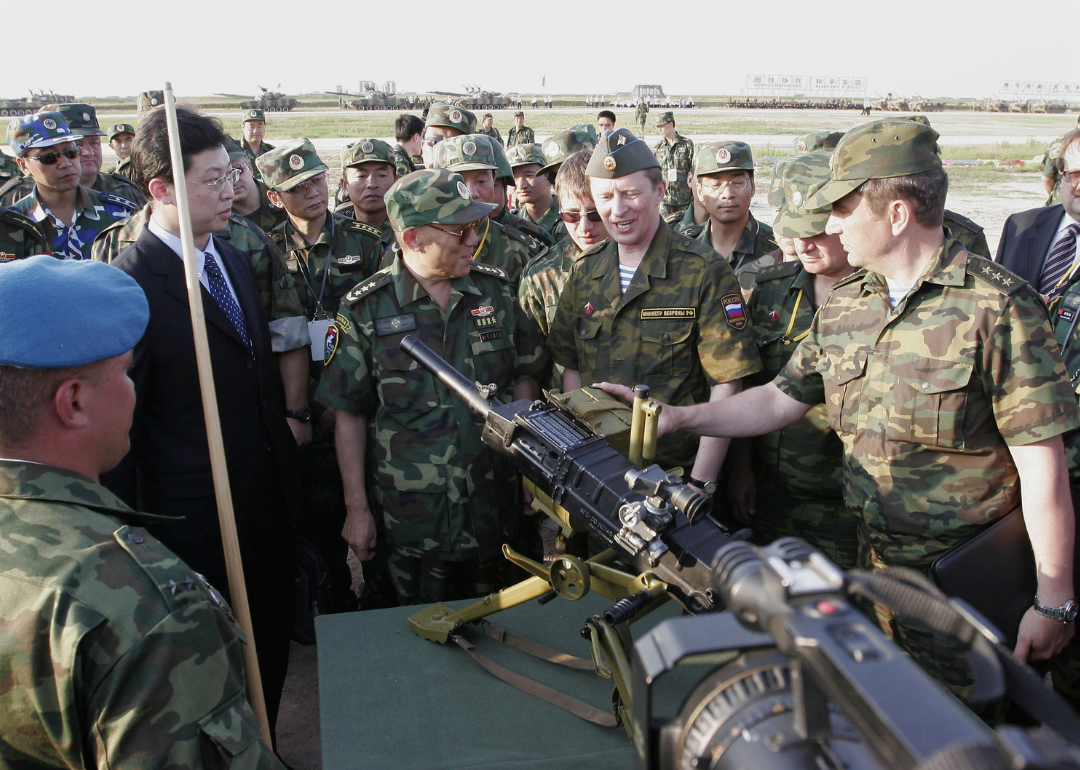
August 2005: China and Russia coordinate and execute their first joint military exercises
China and Russia's military exercises in the summer of 2005 marked the largest joint military operation between the two countries since the Korean War. The exercises, known as Peace Mission 2005, included land, sea, and air practices with submarines, fighter jets, bombers, and other weaponry. Although the two nations declared their intentions were to strengthen their abilities to fight against terrorism and extremism, the advanced nature of their exercises left some Western countries suspicious of their underlying motives.
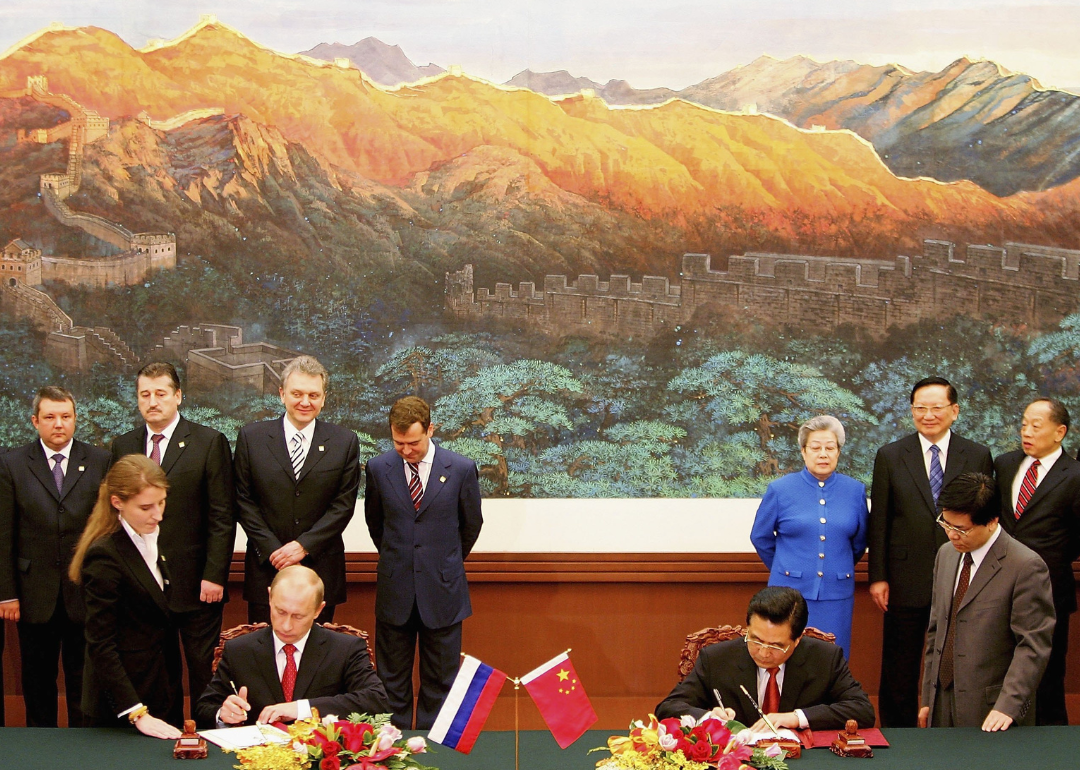
March 2006: Hu Jintao and Vladimir Putin agree to extend energy cooperation
Three deals were signed during Vladimir Putin's visit to China, all aimed at increasing collaboration in the energy, oil, and gas sectors. Both leaders explored the possibility of constructing gas pipelines from Siberia to China to deliver energy commodities from the former to the latter. Additionally, Putin and Hu Jintao both stated their hopes for creating a "trilateral cooperation mechanism" between themselves and India to develop economic and defense forces.
You may also like: History of vaccine mandates in the US
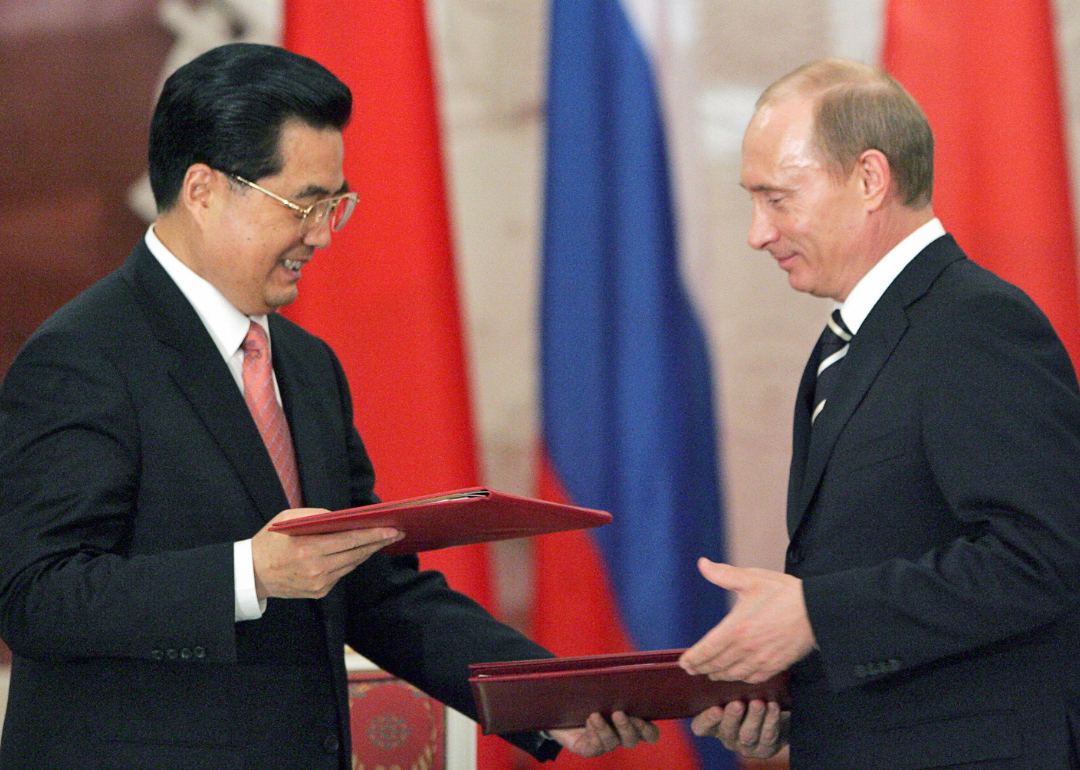
March 2007: Russia and China sign commercial deals worth $4B during Hu Jintao's visit to Russia
China's economy had grown significantly by 2007, leaving President Hu Jintao eager to sign trade deals with Russia, particularly to gain oil and gas securities. As China was the second-highest oil consumer globally and Russia the second-highest oil exporter, both countries stood to gain much from a two-way arrangement. Ahead of his visit to Russia, Hu publicly stated, "At present, Chinese-Russian relations are developing vigorously and have reached unprecedented levels." Chinese officials further disclosed Hu's intentions to close large-scale business deals on his visit, making it much more than a diplomatic journey.
During Hu's visit, Vladimir Putin pointed to the fivefold growth in bilateral trade between the two countries, which by 2007 had reached $30 billion—a harbinger of an even broader growth in this regard in future years.
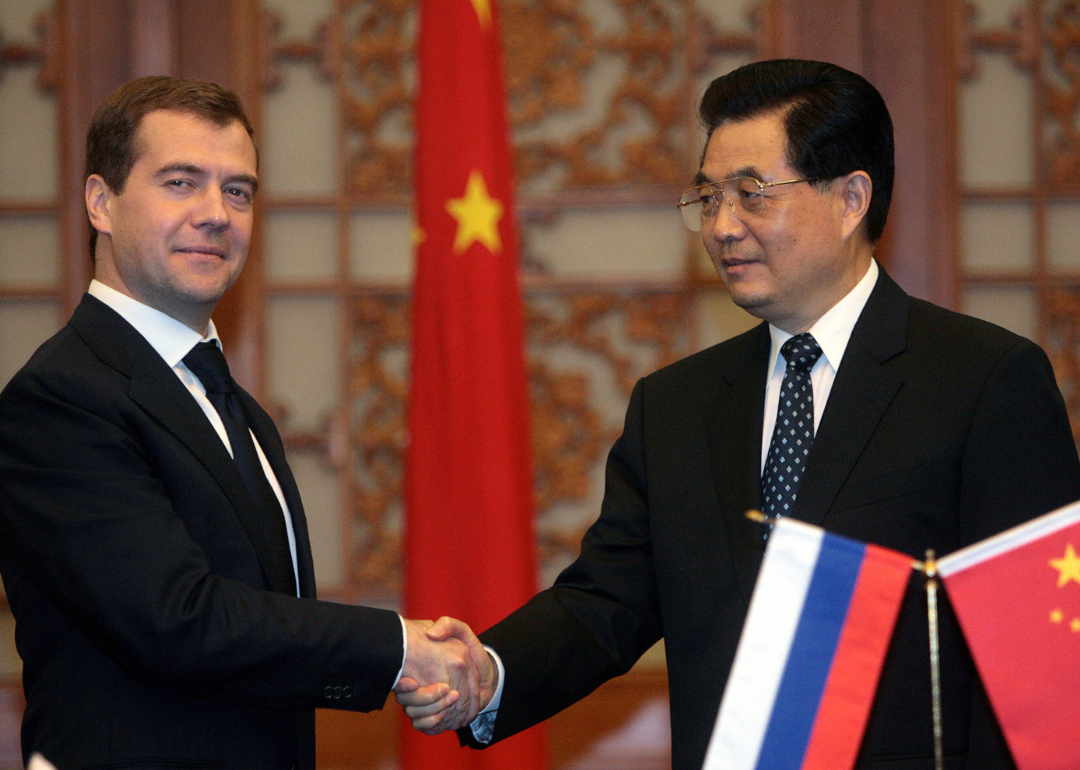
May 2008: Russian President Dmitry Medvedev makes his first foreign trips to Kazakhstan and China
Although Russian presidents traditionally made their inaugural international trips to Europe, newly elected President Dmitry Medvedev instead prioritized Russia's strengthening ties with China by making his first presidential trip to Beijing.
Though Russia had continued to serve in the "elder brother" role—a holdover from the two nations' 1950 Treaty on Friendship, Union, and Mutual Assistance—by 2008, China's economy and military force had grown enough to make it an autonomous nation, sparking an uneasiness among Russian leaders. Harnessing China's massive need for Russia's oil and gas resources provided a way to keep the upper hand, and Medvedev signed a $1 billion contract for a gas centrifuge uranium enrichment plant during his visit, deflecting China's attempts to strike side deals with Kazakhstan and Turkmenistan, which had begun to seem to Russian officials like an alarming extension of Chinese power and influence.
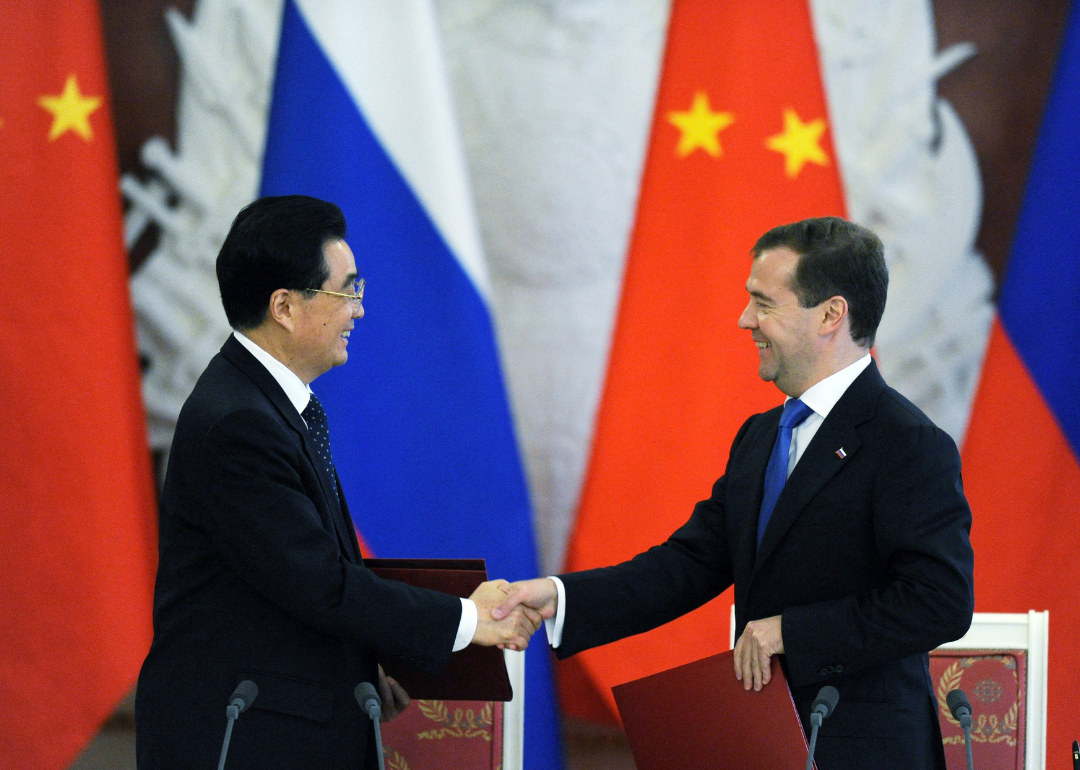
June 6, 2011: China and Russia agree to establish a 'comprehensive strategic partnership' during a meeting on the 10th anniversary of the signing of the Treaty of Good Neighborliness and Friendly Cooperation
Intentions to develop a "comprehensive strategic partnership of cooperation" were seen as an upgrade to the Treaty of Good-Neighborliness and Friendly Cooperation, with more defined and ambitious milestones laid out. A central focus of the new partnership was to jointly develop both nations' space and civil aircraft engineering sectors. Medvedev publicly stated that China and Russia had agreed to aim for bilateral trade benchmarks of $100 billion by 2015 and $200 billion by 2020.
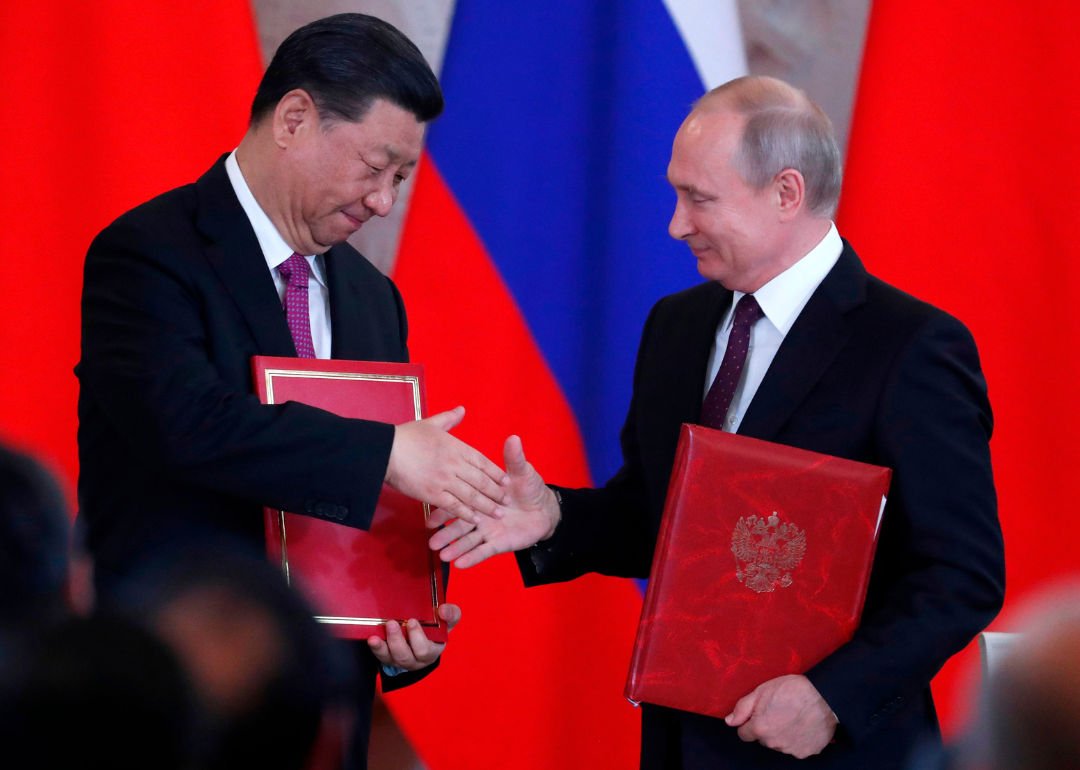
June 5, 2019: Chinese President Xi Jinping visits Russian President Vladimir Putin in Moscow to announce a "new era" of strategic cooperation
President Xi Jinping and reinstalled President Vladimir Putin renewed their two nations' 2011 agreement, calling for a comprehensive strategic partnership, joint spacecraft development, and increased trade. Both countries declared intentions to push forward with the Belt and Road Initiative, which would economically connect 149 East and Central Asian, Middle Eastern, and European countries through the development of railroads, roads, and other infrastructure initiatives. After the meeting, Xi publicly stated that China-Russia relations had entered a "new era" aimed at global strategic stability and the bolstering of safeguards to trade and communication between the two countries.
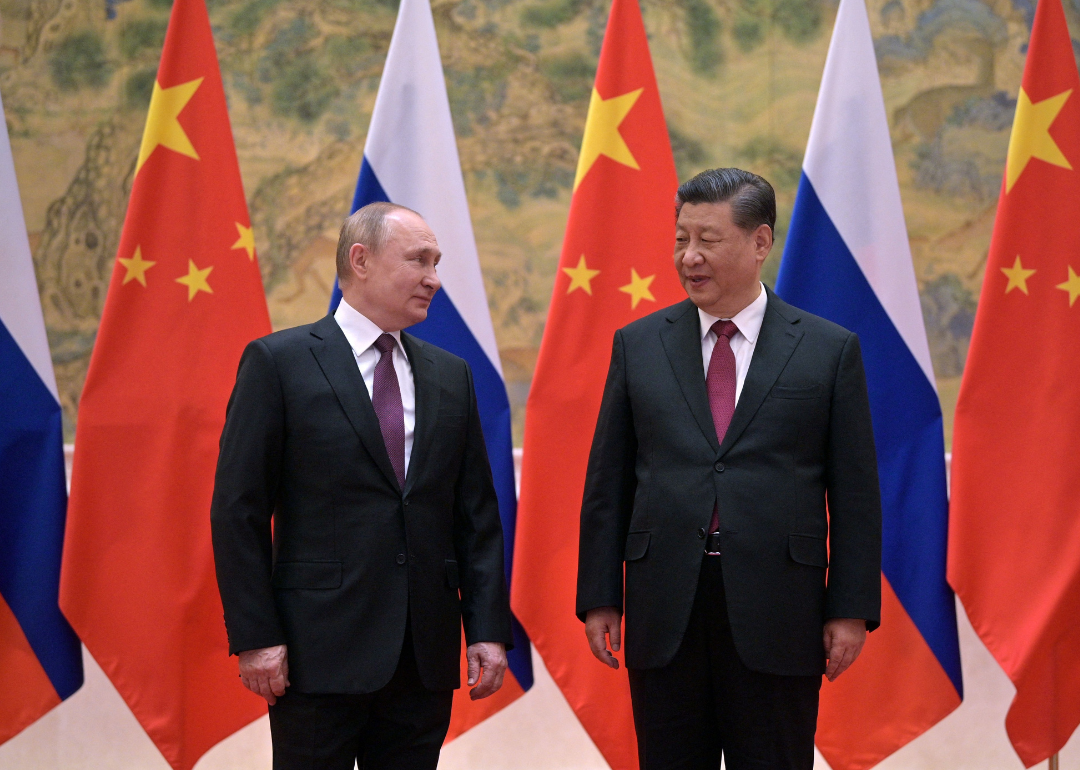
Feb. 4, 2022: Vladimir Putin and Xi Jinping have a meeting on the sidelines of the 2022 Winter Olympic Games in Beijing and make a public statement about the strength of their relationship after the games conclude
The choice of Beijing to host the 2022 Olympic Games was controversial and led to many Western countries boycotting the event, leaving China sorely in need of a public ally. Vladimir Putin's public meeting with Xi Jinping during the games provided this camaraderie, and afterward the two countries issued a joint statement declaring their shared intentions moving forward. Most notable among these "intentions" were curbing both U.S. military expansion in Australia and the upscaling of NATO. The statement shied away, however, from any mention of Chinese support for Russia's invasion of Ukraine, which took place just 20 days later.



